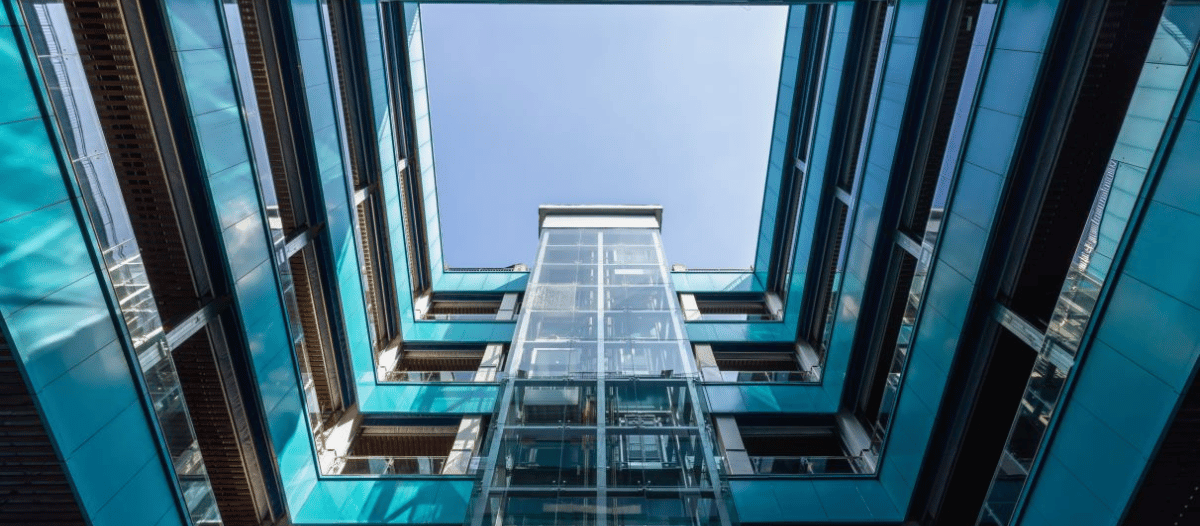Going Green
Planning a sustainable facility

Around the world, more buildings are going green. The U.S. Green Building Council (USGBC) registered nearly 37,000 facilities worldwide with its Leadership in Energy and Environmental Design (LEED) program between January 2017 and December 2021. The average growth rate over that period was 20 percent, which means more facility managers are choosing to pursue a sustainable certification for their new construction or renovation project.
Around the world, more buildings are going green. The U.S. Green Building Council (USGBC) registered nearly 37,000 facilities worldwide with its Leadership in Energy and Environmental Design (LEED) program between January 2017 and December 2021. The average growth rate over that period was 20 percent, which means more facility managers are choosing to pursue a sustainable certification for their new construction or renovation project.
Seeking a building certification is challenging but attainable. Before FMs choose which certification is suitable for their building, they should consider the following guidelines for defining goals, building a project team and exploring design strategies. These practices will be foundational for any green rating and – most importantly – position the project to be a responsible contribution to the built environment.
Vision & goals
Defining a vision is essential for any building project, especially for high-performing, sustainable facilities. With the support of their colleagues, FMs should start by asking themselves: Why is sustainable building important to our organization?
Writing the sustainability story
One of the best ways to answer this question is by establishing a written narrative that tells a compelling story and answers the why. The story-writing process will be most successful if it is a team effort. Working collaboratively with stakeholders will help FMs identify priorities and elevate potential project champions. FMs should welcome representation from all future occupants of the project to help with this effort, including executives, employees, maintenance staff and other daily building users. Stories should also be reinforced with data, such as an existing building’s performance compared to the potential performance of a new building. The narrative can then be shared with stakeholders and the organization's community to secure their buy-in.
Asking the right questions
Once the vision is established, FMs should involve their architect to discuss priorities and define goals for a successful outcome. The design team has the experience and expertise to help engage stakeholders and ask the right questions about the future facility. Some of these questions might be:
-
How is the current building not meeting organizational needs?
-
What would define a successful project?
-
What is the organization’s larger mission, and how does this building fit in?
-
How can the project support business goals, operations or building occupants?
-
How will this project impact the community?
-
What could be done to improve the last building project?
-
Does the organization need a new building or can it renovate an existing one?
Building a team
The most impactful thing an owner can do to improve the performance of a building is to bring together the right team of professionals to help guide the process. The earlier a group is established, the sooner all members can work together to deliver on the project vision and goals.
Earlier is better
FMs and their teams are more likely to hit all the milestones established by the accrediting organization when their goals and team are in place before starting the design phase. The team should include owner stakeholders, architects, engineers, contractor partners and commissioning agents who will set the pace for making critical decisions. Ideally, this will be the same team that is part of the master planning phases or early building assessments; they will be more effective advocates if they have the full context of that initial work.
This team can offer expertise in high-performance systems, sustainable strategies and healthy materials. For example, the team can create energy and daylighting models throughout the design process to help their clients visualize the potential energy and cost savings for their new building. FMs can present this data to their stakeholders to help make informed decisions. They can also help FMs with the technical work of documenting these decisions and getting the required government approvals, allowing FMs to stay focused on keeping their stakeholders engaged and updated about the project.
Exploring design strategies
Selecting a specific green building certification depends on each organization's goals. Nevertheless, there are several design strategies that create the foundation of every rating system. Whether or not they pursue a certification, facility managers should evaluate the following recommendations to achieve a high-performing, sustainable building project.
Location & site
FMs and their teams must think carefully about the land upon which the new building will stand. They should seek to avoid greenfield sites (undeveloped land), wetlands or other fragile ecosystems whenever possible. These sites are often disconnected from critical infrastructure, such as utilities and roadways. Instead, the team might consider brownfield sites (previously developed land that is not in use) or, better yet, areas with existing buildings that could be renovated.
They should also consider how the building can and will relate to its community. Could employees, students or clients walk to the building? Is there access to existing public transportation? Maybe there are nearby trails or bike paths. Many green building programs provide points for facilities with these types of amenities.
Building massing
Massing refers to the overall configuration of the building. It is essential to consider how the new building fits on the site and to take advantage of the existing land features. This could mean working with the existing topography to leverage natural drainage patterns, maintaining mature trees for shading or locating the building to minimize excavation, which is energy intensive and costly.
FMs should also consider how the sun pattern will cross the building. Orienting it on the east-west axis will allow plentiful sunlight from the south (in the northern hemisphere) or the north (in the southern hemisphere). The difference in the sun's height between the summer and winter months will impact the seasonal lighting and heating of the building. Proper orientation and strategically placed windows and shades allow natural light to enter in the winter, when the sun is less intense, and protect the building from excessive solar heat gain in the summer. This reduces the active heating and cooling loads during those seasons and helps lower energy costs.
Energy use
Buildings consume a lot of energy. In the U.S., they account for about 40 percent of the country's total energy consumption, so finding ways to reduce it is a central part of any green rating system.
Knowing how much energy the new building will use in a project's planning and design phases is essential. The team of architects, engineers and consultants can help FMs predict the building's energy use intensity (EUI). This metric – calculated by dividing the building's total energy use in one year by the total gross floor area – is a benchmark for comparing the building's performance to others in its industry and determining performance improvements above a baseline building.
There are several ways FMs and their project teams can improve a building's predicted EUI in the early stages of design, starting with the building's envelope. Strategically placed, high-performance windows could eliminate the need for perimeter heating. Maximizing roof and wall insulation will help a building retain its indoor climate and reduce the burden on its heating and cooling system. High-efficiency HVAC, automatic lighting controls and smart building systems can lower the EUI by learning how occupants use the building and adjusting to their patterns, minimizing wasted energy.
FMs should also explore on-site renewable energy options, including geothermal, solar and wind. Although these systems will not reduce the building's energy demand, they will significantly reduce utility consumption – many of which rely on fossil fuels as an energy source. Even if it is not feasible to implement these systems immediately, managers should consider how to prepare the building for future installations. If a net zero energy building is being considered, on-site energy generation is essential.
Water use & reclamation
Strategic water use can reduce operational costs and the building's environmental impact. Project teams should consider the building's relationship to water inside and outside.
On the exterior, thoughtful landscaping can improve how a building handles rainfall. Specifying drought-resistant, native landscaping around the building can reduce maintenance and eliminate the need for irrigation. The plants are also more durable and can act as sponges during heavy rain events.
Instead of sending rainwater directly to the sewer, FMs should consider adding vegetation or temporary water storage systems to the building's roof, often referred to as green and blue roofs, respectively. These systems will minimize the amount of water that rushes to sewer systems and reduce the likelihood of flooding on the building's site. The building could also capture and store rainwater for watering plants and flushing toilets if the jurisdiction allows the use of greywater – wastewater without serious contaminants – for certain functions.
On the interior, low-flow plumbing fixtures and water-saving appliances are one of the most straightforward ways to reduce water consumption. In the U.S., products with a WaterSense label meet the Environmental Protection Agency's criteria for efficient water usage and suit buildings targeting green certification. Reducing process water usage – for example, using condensate capture and recycled water in chiller systems – should also be considered.
Materials
Buildings play an outsized role in generating waste. According to the EPA, the amount of construction and demolition debris the U.S. generated in 2018 was more than twice as much as municipal solid waste. Project design teams can be more efficient with their materials by designing to standard product dimensions or using modular and prefabricated designs to reduce material usage.
Teams should also review the source of materials. Regional materials will arrive at the construction site with a reduced carbon footprint compared to globally sourced materials. Reclaimed construction materials are a good option for reducing the building’s environmental impact, especially if harvested locally.
Material considerations continue long after installation. Healthy buildings feature products and finishes with low or no volatile organic compounds – chemicals within a product that slowly release into the indoor air and can make occupants sick. It is also vital to match high-traffic locations with durable materials to minimize the need for replacement. Modular installations – like carpet tiles instead of broadloom – are a good choice because they allow for replacing only the most worn sections rather than a completely new installation. Lastly, end-of-life disposal should be considered; many companies offer take-back programs to avoid materials ending up in landfills.
Indoor quality
Regardless of who the new building will serve, its success will depend on occupants' health and comfort. Ambient temperature, lighting and acoustics are critical factors in a building's indoor quality.
One of the most frequent complaints FMs receive from building occupants is temperature. When planning a new building, consider opportunities for mechanical zoning to allow spaces to be heated or cooled at different rates. The design team can also recommend systems – such as an underfloor air distribution system – that allow for higher levels of individual temperature control. Building automation systems can prioritize energy use in the zones that need temperature adjustments rather than heating or cooling the entire building.
Studies show a positive correlation between natural lighting and occupants' well-being and productivity. Daylighting strategies such as skylights, clerestory windows and light shelves provide soft natural light with minimal glare. Windows, of course, have the additional benefit of providing views of the outdoors, an amenity that has proven benefits for people's health.
Excessive noise can hinder worker and student performance and agitate patients. While planning the building, FMs should connect with individual departments to better understand how they use their spaces. Armed with this knowledge, they can be more sensitive to adjacencies, ensuring that the school's band room, for example, does not disrupt the library.
Preparing projects for success
These practical guidelines will help FMs plan for a successful building. They provide a starting point for pursuing a green building credential because many programs are founded on these standards. Most certification programs share similar criteria, allowing well-qualified buildings to receive multiple certifications. Whether or not a building receives an official certification, these strategies outline a path toward healthier facilities that will support the building’s occupants for decades.


Phil Meyer, AIA, LEED AP BD+C is a senior project architect in EUA’s workplace studio. He believes the most inspiring workspaces support the three pillars of sustainable design: people, place and performance. Meyer is especially interested in building performance simulations and project data, and he enjoys working with his teams to incorporate energy and daylight analysis into the project delivery process.

Emily McNamara, AIA, LEED AP BD+C is a senior project architect in EUA’s health care studio. She specializes in facility planning and enjoys collaborating with physicians, nurses and staff to understand their needs to deliver the best patient care. McNamara is passionate about sustainable design and has delivered high-performing buildings for many of the largest healthcare providers in southeastern Wisconsin.
References
Aalok Vinod Jhunjhunwala, “LEED Data Trends from the Past Five Years,” U.S. Green Building Council, October 12, 2022, usgbc.org/articles/leed-data-trends-past-five-years.
“Policy & Advocacy: Buildings,” Alliance to Save Energy, accessed January 3, 2023, ase.org/categories/buildings.
“Construction and Demolition Debris: Material-Specific Data," United States Environmental Protection Agency, accessed January 4, 2023, epa.gov/facts-and-figures-about-materials-waste-and-recycling/construction-and-demolition-debris-material.
Read more on Project Management , Real Estate and Sustainability
Explore All FMJ Topics









